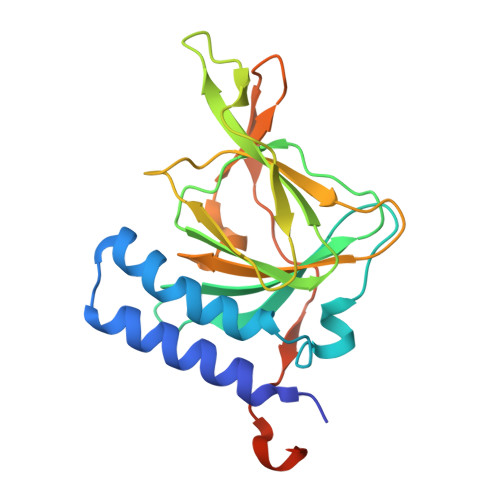Substrate and pH-Dependent Kinetic Profile of 3-Mercaptopropionate Dioxygenase from Pseudomonas aeruginosa.
Fellner, M., Aloi, S., Tchesnokov, E.P., Wilbanks, S.M., Jameson, G.N.(2016) Biochemistry 55: 1362-1371
- PubMed: 26878277
- DOI: https://doi.org/10.1021/acs.biochem.5b01203
- Primary Citation of Related Structures:
4WVZ - PubMed Abstract:
Thiol dioxygenases catalyze the synthesis of sulfinic acids in a range of organisms from bacteria to mammals. A thiol dioxygenase from the bacterium Pseudomonas aeruginosa oxidizes both 3-mercaptopropionic acid and cysteine, with a ∼70 fold preference for 3-mercaptopropionic acid over all pHs. This substrate reactivity is widened compared to other thiol dioxygenases and was exploited in this investigation of the residues important for activity. A simple model incorporating two protonation events was used to fit profiles of the Michaelis-Menten parameters determined at different pH values for both substrates. The pKs determined using plots of k(cat)/Km differ at low pH, but not in a way easily attributable to protonation of the substrate alone and share a common value at higher pH. Plots of k(cat) versus pH are also quite different at low pH showing the monoprotonated ES complexes with 3-mercaptopropionic acid and cysteine have different pKs. At higher pH, k(cat) decreases sigmoidally with a similar pK regardless of substrate. Loss of reactivity at high pH is attributed to deprotonation of tyrosine 159 and its influence on dioxygen binding. A mechanism is proposed by which deprotonation of tyrosine 159 both blocks oxygen binding and concomitantly promotes cystine formation. Finally, the role of tyrosine 159 was further probed by production of a G95C variant that is able to form a cysteine-tyrosine crosslink homologous to that found in mammalian cysteine dioxygenases. Activity of this variant is severely impaired. Crystallography shows that when un-crosslinked, the cysteine thiol excludes tyrosine 159 from its native position, while kinetic analysis shows that the thioether bond impairs reactivity of the crosslinked form.
- Department of Chemistry and ‡Department of Biochemistry, University of Otago , P.O. Box 56, Dunedin 9054, New Zealand.
Organizational Affiliation:

















